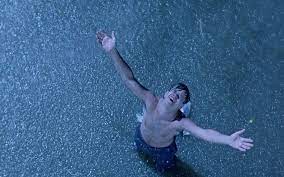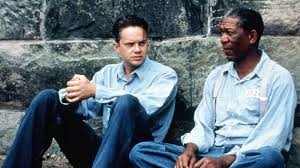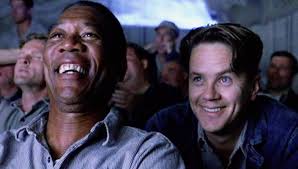The Shawshank Redemption (1994)

Review of The Shawshank Redemption (1994)
Frank Darabont’s The Shawshank Redemption (1994) is widely regarded as one of the greatest films ever made, and for good reason. Adapted from Stephen King’s novella Rita Hayworth and Shawshank Redemption, this poignant tale of hope, friendship, and resilience is a cinematic masterpiece. With exceptional performances, a compelling narrative, and profound themes, the film resonates deeply with audiences across generations.
Plot Overview
Set in the 1940s, the story follows Andy Dufresne (Tim Robbins), a banker wrongfully convicted of murdering his wife and her lover. Sentenced to two consecutive life terms at Shawshank State Penitentiary, Andy must navigate the brutal realities of prison life while maintaining his sense of identity and hope. Along the way, he befriends Ellis “Red” Redding (Morgan Freeman), a long-time inmate who becomes his confidant and ally.
Through their bond, the film explores themes of friendship and endurance against adversity. Andy’s intelligence and quiet determination allow him to make an indelible impact on those around him, from improving the prison library to helping the warden with financial schemes. Beneath its grim setting, the story is ultimately one of triumph, culminating in an unforgettable and emotionally satisfying conclusion.
Themes and Symbolism
1. Hope and Resilience
The central theme of The Shawshank Redemption is the enduring power of hope. Andy’s unwavering belief in freedom and a better future stands in stark contrast to the oppressive environment of Shawshank. His famous line, “Hope is a good thing, maybe the best of things, and no good thing ever dies,” encapsulates the film’s core message.
While many inmates, including Red, initially view hope as dangerous or futile, Andy’s actions demonstrate that hope can be a source of strength and transformation. His secret plans and acts of defiance—such as playing opera music over the prison’s loudspeakers—remind both the characters and the audience of the beauty and freedom that exist beyond physical confines.
2. Friendship and Human Connection
At the heart of the film is the friendship between Andy and Red. Their bond provides solace and purpose in a bleak and dehumanizing environment. Red’s transformation from a man resigned to his fate to someone inspired by Andy’s hope underscores the importance of human connection in overcoming life’s hardships.
The camaraderie among the prisoners—whether it’s in small acts of kindness or shared moments of joy—illustrates the resilience of the human spirit and the necessity of community, even in the harshest conditions.
3. Institutionalization and Freedom
The film delves deeply into the psychological impact of long-term incarceration. Through characters like Brooks Hatlen (James Whitmore), a gentle, elderly inmate who struggles to adjust to life outside prison, the story examines the concept of institutionalization. Shawshank becomes more than a prison; it is a place where the inmates feel both trapped and safe, a paradox that highlights the difficulty of reclaiming freedom after decades of confinement.
Andy’s escape from Shawshank serves as a powerful metaphor for liberation, not just from physical imprisonment but also from mental and emotional constraints. His meticulous planning and eventual triumph are a testament to the strength of perseverance and ingenuity.
Performances and Characterization
The film’s success owes much to its stellar cast, led by Tim Robbins and Morgan Freeman. Robbins’ portrayal of Andy Dufresne is understated yet deeply impactful. He captures Andy’s quiet strength, intelligence, and humanity, making him a protagonist who is both relatable and inspiring.
Morgan Freeman’s performance as Red is equally iconic. His warm, gravelly narration provides a reflective and emotional anchor for the story. Freeman’s portrayal of Red’s growth—from a cynical observer to a man renewed by hope—is a masterclass in acting.
The supporting cast, including Bob Gunton as the corrupt and tyrannical Warden Norton and Clancy Brown as the brutal Captain Hadley, add depth and tension to the narrative. Each character, no matter how minor, contributes to the rich tapestry of Shawshank’s world.
Direction and Cinematography
Frank Darabont’s direction is both restrained and evocative, allowing the story and characters to take center stage. The pacing is deliberate, building a sense of immersion and emotional investment as the audience becomes part of life within Shawshank.
Roger Deakins’ cinematography enhances the film’s atmosphere, using light and shadow to emphasize both the bleakness of prison life and the moments of transcendence. The juxtaposition of the grim prison setting with Andy’s glimpses of hope—such as the stunning shot of him standing in the rain after his escape—creates powerful visual symbolism.
Score and Soundtrack
Thomas Newman’s score is another standout aspect of the film. The music underscores the emotional beats of the story, from moments of despair to the soaring hope of the final scenes. The use of opera during Andy’s act of rebellion is particularly memorable, serving as a poignant reminder of art’s ability to uplift and inspire.
Legacy and Impact
Though it was initially overshadowed by other films upon its release, The Shawshank Redemption has since gained a devoted following and critical acclaim. Its themes of hope, friendship, and redemption have universal appeal, resonating with audiences across cultures and generations. The film’s high placement on numerous “greatest films” lists, including IMDb’s top-rated movies, is a testament to its enduring impact.
Beyond its accolades, the film has become a cultural touchstone, with its quotes, scenes, and characters deeply ingrained in popular consciousness. Its message of resilience and optimism continues to inspire viewers, making it a film that stands the test of time.
Conclusion
The Shawshank Redemption is more than just a film; it is a profound and uplifting experience. With its masterful storytelling, unforgettable performances, and timeless themes, it remains a benchmark of cinematic excellence. Frank Darabont’s adaptation of Stephen King’s novella transforms a tale of imprisonment into a universal story of hope and humanity.
Whether you’re watching it for the first time or revisiting it after many years, The Shawshank Redemption is a film that leaves an indelible mark on the soul. It reminds us that even in the darkest of times, hope can set us free.